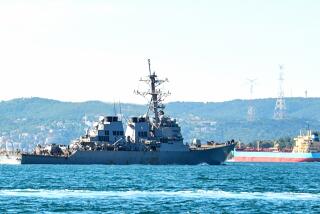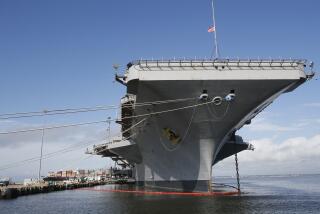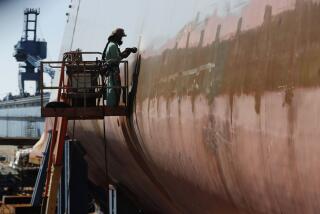Naval Machismo Has No Peacetime Role
- Share via
The deaths of more than three dozen American sailors and the disabling of a $325-million frigate in the Persian Gulf is a tough lesson for the U.S. Navy. But recent history shows the accident to have been both predictable and avoidable, representing a clear failure of maritime strategy.
Former Secretary of the Navy John F. Lehman pursued his dream of a grand naval plan, enlarging the fleet to more than 600 vessels and showing the flag more aggressively worldwide. Yet the destruction of the Stark is only the latest in a long line of striking examples of ships’ increasing vulnerability to modern homing missiles. It is time for the Navy to admit that “power projection,” “forward deployment,” sailing “in harm’s way” and naval machismo are no longer viable, safe options for peacetime operations.
British, French and, in particular, Soviet and American naval strategies in the gulf and nearby Arabian Sea--providing military escort to tankers and freighters and placing commercial vessels under national flags--only serve to escalate the long Iran-Iraq war and unnecessarily risk direct superpower involvement.
The French-built Exocet missile, which struck the Stark, unleashed a similar, startling naval incident just five years ago in the Falklands. The Sheffield, a $150-million British destroyer, lacked sufficient time and/or equipment to identify and counterattack an Argentine navy Super Etendard fighter-bomber armed with the same sea-skimming, anti-ship missile. The Exocet slammed just above the waterline and, although it failed to detonate, sparked a conflagration that destroyed Sheffield in five hours. Twenty sailors died and the ship’s smoking hulk was scuttled. The two-month Falklands war witnessed nine more ships lost by Argentina and Britain,more than half to so-called smart missiles.
The new Iranian anti-ship missiles situated along the Strait of Hormuz also have exhibited past successes in naval warfare. The Chinese-built Hai Ying 2, or Silkworm, is a cousin to the Soviet Styx missile that made history 20 years ago in the eastern Mediterranean. Israeli sailors on board the destroyer Elath curiously spied a long, delta-winged, green missile slowly approaching from the direction of Port Said in Egypt. It appeared off-course. But as the Elath swung to fire, the missile suddenly veered toward the destroyer and struck amidships through a hail of machine-gun bullets.
The 2,500-ton Elath, largest in Israel’s navy although considerably smaller than the Stark, quickly sank beneath the waves as three additional Styx struck, all fired from a 100-ton Egyptian ship 10 miles over the horizon.
It is likely that such catastrophe will strike additional U.S., Soviet or other warships and commercial vessels in the Arabian Sea or the Persian Gulf. Iraq brags of having destroyed more than 200 noncombatant ships in the gulf since 1982, an average of three dozen annually, with its now-famous Exocet-armed Mirage and Etendard aircraft; it also sails a dozen ships armed with the Styx missile. Iran possesses an equal number of ships with the new 70-mile-range American Harpoon anti-ship missile. At least a dozen other modern, precision-guided missiles have been sold by superpower and allied sources to Persian Gulf states.
These anti-ship smart missiles are dumber than proponents admit and can easily strike an escort ship accidentally while searching for other ship silhouettes on the horizon. This may have been the case with both the Stark and the Sheffield, and was most certainly the case in 1967 when Australian and American ships were struck by U.S. jet fighters off the Vietnam coast.
Debate around the loss of the Stark will focus predictably on technical and tactical issues: whether its defensive guns, including the high-tech Phalanx system that spews out a “wall of uranium-core bullets,” could have stopped the Exocet; why the captain did not fire; whether the ship’s radars were working.
But the real issue is whether such limited naval presence in a war zone serves any American purpose. Does it encourage political resolution of the gulf war? Does it guarantee Persian Gulf oil to the West? In reality, such a naval strategy accomplishes none of these goals, but only serves to expand the conflict far beyond Iranian and Iraqi borders.
Setting up a superpower-supplied shooting gallery in the gulf, and then assuming we are bullet-proof when we sail through it, does not represent smart or peaceful foreign policy.
Before we and the Soviets flirt with such dangerous escalation, we must decide whether we want to risk full-blown superpower involvement. Continuing the current naval blindman’s bluff serves no good purpose.
It is time for us to remain more safely back in the Mediterranean and Indian Ocean, showing our presence and affording graduated and careful responses to any crisis but precluding sudden, real or accidental attack by sophisticated, now-proven missiles in an unpredictably volatile region.
More to Read
Sign up for Essential California
The most important California stories and recommendations in your inbox every morning.
You may occasionally receive promotional content from the Los Angeles Times.










